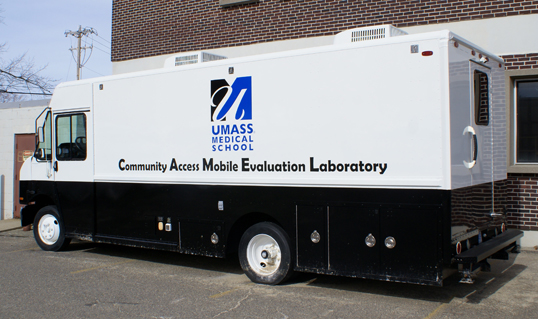
The Shriver Center's new mobile lab, known as CAMEL for Community Access Mobile Evaluation Laboratory, enables Center personnel to conduct research in field settings.
The Eunice Kennedy Shriver Center is a unit of the Center for Health Policy and Research in the Commonwealth Medicine division. It comprises the Intellectual and Developmental Disabilities Research Center; the University Center of Excellence in Developmental Disabilities and Leadership Education in Neurodevelopmental and Other Related Disabilities. For more information, visit the Shriver Center website.
Thanks to innovative thinking and a new federal grant, the Eunice Kennedy Shriver Center can take their research on the road in a new mobile laboratory.
The Shriver Center, a division of UMass Medical School that develops research, education and service programs aimed at improving the quality of life for people with intellectual and developmental disabilities and their families, has recently acquired a mobile laboratory through a grant from the Health Resources and Services Administration of the U.S. Department of Health and Human Services and the National Institute for Child Health and Human Development.
The mobile lab, known as CAMEL for Community Access Mobile Evaluation Laboratory, was purchased from and retrofitted by a company in Ohio that customizes service vehicles for very specialized use—including SWAT and mobile medical vehicles.
“CAMEL can go anywhere. We just need power and parking,” said Teresa Mitchell, PhD, assistant professor of psychiatry. William McIlvane, PhD, professor of psychiatry and director of the Shriver Center, attained funding for the vehicle and partnered with Dr. Mitchell in acquiring and outfitting the mobile lab.
CAMEL is currently being used to collect eye tracking data and EEG scans from participants at schools with which the Shriver has longstanding partnerships. Since space is almost always at a premium in schools, having the mobile lab onsite but out of the building further lessens the burden on partner schools.
The eye tracking studies being performed allow researchers to use “very clever equipment,” according to Dr. Mitchell, to measure exactly what a person is looking at on a computer screen. “The participant is not always able to easily articulate where or what they are looking at. We may have them look at a human face on a computer screen to see exactly where they are focusing, which allows us to determine if they are missing important signals being communicated nonverbally.” This is especially useful with individuals with an autism spectrum disorder. The data could be used in developing and designing interventions for individuals with developmental disabilities.
EEG scans are used to measure tiny changes—on the order of microvolts—in the electrical activity in the brain. This data can be useful in evaluating brain activity in people with developmental disabilities and associated brain dysfunction. Because the changes are so minute, the environment in which the testing takes place is very important. “We need a very clean environment, away from computers and other electronic equipment,” said Mitchell. “In the mobile lab, we can control the environment and record the smallest signal changes.”
While the same types of precise measurements can achieved in the Shriver labs, many of the special populations that Shriver hopes to reach find it challenging to come to the labs. “We partner with schools that serve developmentally disabled students, and while many students and their families want to participate in studies that improve outcomes, getting to the Shriver labs in Waltham in the middle of a school and work day is impossible,” said Mitchell “So now these families can participate.”
CAMEL also allows Shriver to branch out into regions of the state that before were out of reach. So far, CAMEL has been taken to communities on the Cape and on the Rhode Island border that have shown interest in participating in research. Mitchell hopes to expand the research area not only geographically but also in terms of socio-economic diversity.
With the burden of transportation removed, CAMEL opens up a lot of opportunities that didn’t exist before. “We don’t have to rely solely on a 10-to-15 mile radius for recruiting anymore,” said Mitchell.